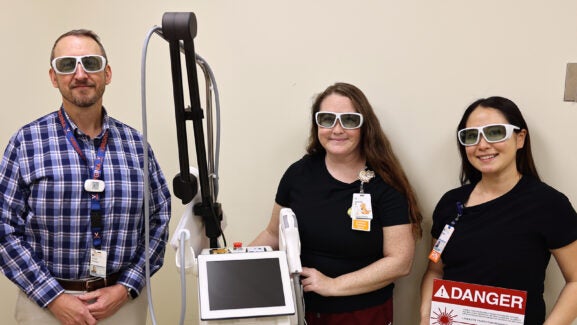

Clarissa Lynch, Chemical Safety Officer and Assistant Director for Research Safety
Safety and Security: Why We Rely on Safety Data Sheets
Multiple hazardous chemicals are used throughout our hospital for a variety of essential tasks, from research and testing to sterilization and imaging and more. If your job puts you in close contact with one of these chemicals, then Safety Data Sheets (SDS) — formerly known as material safety data sheets or MSDS — are your go-to for tips on safe handling and storage.
“The SDS is that key resource for understanding how to properly identify what’s hazardous and how to handle it, store it, and dispose of it,” says Clarissa Lynch, UVA’s Chemical Safety Officer and Assistant Director for Research Safety.
Having SDS readily accessible to employees is a mandatory Occupational Safety and Health Administration (OSHA) Hazard Communication Standard requirement. At UVA Health, all health system computers have an MSDS icon on the home screen that will take you directly to a searchable database of safety data sheets. “It is one of the largest databases available, with millions of safety data sheets, not just the ones specific to UVA,” says Lynch.
Should you have trouble locating a specific SDS, Lynch advises reaching out to Environmental Health and Safety (EHS). “We can request to have a safety data sheet added to the database or help you search for it more effectively,” she says.
If electronic access is unavailable in your area, hard copies must be provided to ensure everyone can obtain this critical information when needed.
What You Can Learn from SDS
According to Lynch, “there’s a lot of information packed into every SDS.” Each one outlines crucial details for a specific chemical, including:
- The type of hazard associated with the chemical (flammability, toxicity, corrosiveness)
- How to safely handle and store the chemical
- Which personal protective equipment (PPE) is recommended when working with a chemical
- How to respond to a spill or exposure, including first-aid
- The composition and physical properties of the chemical
To ensure regulatory compliance and staff safety, UVA Health provides mandatory chemical safety training in Workday for new employees who will work with or near hazardous chemicals. This training will provide guidance on how to access and interpret the SDS, in addition to safe handling procedures.
Tips for Chemical Safety
Whether you're handling flammable solvents or basic disinfectants, here are some key safety points to remember:
- Always read the SDS before using a new chemical.
- Pay close attention to the hazard identification section to understand potential risks.
- Check the handling and storage guidelines, including any incompatibilities.
- Review PPE recommendations to ensure you’re properly equipped.
- Familiarize yourself with engineering controls, such as chemical fume hoods, where appropriate.
If you have specific questions about the chemical products you’re working with, Lynch advises first speaking with your direct supervisor and then reaching out to EHS. “EHS is always a reliable resource for questions related to chemical safety,” she says.
Latest News



